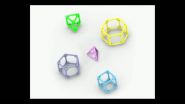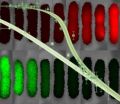Stirring the simmering 'designer baby' pot
Hastings Center President Emeritus Thomas H. Murray, writing in Science, asks, how much discretion should parents have in determining what sort of child they have?
2014-03-13
(Press-News.org) (Garrison, NY) From genetic and genomic testing to new techniques in human assisted reproduction, various technologies are providing parents with more of a say about the children they have and "stirring the pot of 'designer baby' concerns," writes Thomas H. Murray, President Emeritus of The Hastings Center, in a commentary in Science.
Murray calls for a national conversation about how much discretion would-be parents should have. "Preventing a lethal disease is one thing; choosing the traits we desire is quite another," he writes.
He discusses public hearings two weeks ago by the United States Food and Drug Administration to consider whether to permit human testing of a new method of assisted reproduction – mitochondrial manipulation – that would prevent the transmission of certain rare diseases and perhaps address some causes of female infertility. At issue is the safety of the technology, as well as its ethical implications.
Mitochondrial manipulation creates an embryo with the nuclear DNA from the prospective mother and father (which contains most of the genetic material) and the mitochondrial DNA (containing 37 genes) from a donor without mitochondrial defects. Among the ethical concerns is that daughters produced by this procedure could pass down the mitochondrial DNA to their children. "Up to now, the United States has not allowed such genetic changes across generations," Murray writes.
He says that the FDA's discussion is the latest development that "tapped into a simmering controversy over what it means to have a child in an era of increasing convergence among genetic, genomic, and reproductive technologies." Those technologies include preimplantation genetic diagnosis (genetic analysis of embryos before implantation via in vitro fertilization) and prenatal screening to detect health problems in the fetus, including the prospects of a blood test of a pregnant woman to screen fetal DNA in her blood.
"Of all the possible choices prospective parents might make, sex selection for non-medical purposes has prompted the strongest policy response, "Murray writes. "It is prohibited in at least 36 countries, but not in the United States." He notes that "conflicts over the legal and moral status of embryos and fetuses have discouraged American legislators from proposing sensible regulations, lest they be drawn in to the abortion debate."
The absence of federal legislation has left the regulation of sex selection up to professional societies. But they have different guidelines, reflecting "clashing ethical frameworks for thinking about parenthood in the genomic era."
Murray calls for a national conversation about current and emerging technologies shaping the choices that parents have, beginning with an examination by the U.S. Presidential Commission for the Study of Bioethical Issues. "It will not be easy to avoid the quicksand of the abortion debate," he writes, "but it would be a great public service to provide a sober assessment of the choices that would-be parents increasingly face, and to encourage a respectful dialogue about the meaning of parenthood and the worth of a child so that parents and children can flourish together."
INFORMATION:
To read the article, contact Science here. The article will be available at 2:00 pm Eastern time.
ELSE PRESS RELEASES FROM THIS DATE:
Roomy cages built from DNA
2014-03-13
VIDEO:
To create supersharp images of their cage-shaped DNA polyhedral, the scientists used DNA-PAINT, a microscopy method that uses short strands of DNA (yellow) labeled with a fluorescent chemical (green) to...
Click here for more information.
BOSTON, March 13, 2014 – Move over, nanotechnologists, and make room for the biggest of the small. Scientists at the Harvard's Wyss Institute have built a set of self-assembling DNA cages one-tenth as wide as a bacterium. The structures ...
One in 5 older Americans take medications that work against each other
2014-03-13
PORTLAND, Ore. – About three out of four older Americans have multiple chronic health conditions, and more than 20 percent of them are being treated with drugs that work at odds with each other – the medication being used for one condition can actually make the other condition worse.
This approach of treating conditions "one at a time" even if the treatments might conflict with one another is common in medicine, experts say, in part because little information exists to guide practitioners in how to consider this problem, weigh alternatives and identify different options.
One ...
These boosts are made for walkin'
2014-03-13
Whether you're a Major League outfielder chasing down a hard-hit ball or a lesser mortal navigating a busy city sidewalk, it pays to keep a close watch on your surroundings when walking or running. Now, new research by UC San Francisco neuroscientists suggests that the body may get help in these fast-changing situations from a specialized brain circuit that causes visual system neurons to fire more strongly during locomotion.
There has been a great deal of research on changes among different brain states during sleep, but the new findings, reported in the March 13 issue ...
Some racial disparities in childbirth more environmental than genetic
2014-03-13
A new study investigating racial disparities in birth outcomes shows that contrary to some theories Vitamin D is unlikely to play a role in differences in preterm birth and low birth weight between African-Americans and whites.
"For years there has been this hypothesis that African-Americans have worse birth outcomes because they have more melanin in their skin which reflects the sun and therefore lowers levels of Vitamin D," said study author Zaneta Thayer, PhD, assistant professor of anthropology at the University of Colorado Denver . "But in examining the relationship ...
New satellite movie shows massive Eastern US cool down
2014-03-13
VIDEO:
This animation of NOAA's GOES satellite data shows the progression of the major winter storm over the US Mid-Atlantic and northeastern US on March 12 and 13.
Click here for more information.
Three days of satellite imagery from NOAA's GOES-East satellite were compiled into an animation that showed the progression of the storm system that drastically changed temperatures in the Mid-Atlantic and Northeastern U.S. from spring-like warmth to the bitter cold of winter.
A ...
Study suggests potential association between soy formula and seizures in children with autism
2014-03-13
MADISON — A University of Wisconsin-Madison researcher has detected a higher rate of seizures among children with autism who were fed infant formula containing soy protein rather than milk protein.
The study found excess seizures among girls and in the total sample of 1,949 children. The soy-seizure link reached borderline significance among boys, who comprised 87 percent of the children described in the database under study.
Seizures — caused by uncontrolled electrical currents in the brain — occur in many neurological disorders including epilepsy, Alzheimer's disease, ...
A gene family that suppresses prostate cancer
2014-03-13
ITHACA, N.Y. – Cornell University researchers report they have discovered direct genetic evidence that a family of genes, called MicroRNA-34 (miR-34), are bona fide tumor suppressors.
The study is published in the journal Cell Reports, March 13.
Previous research at Cornell and elsewhere has shown that another gene, called p53, acts to positively regulate miR-34. Mutations of p53 have been implicated in half of all cancers. Interestingly, miR-34 is also frequently silenced by mechanisms other than p53 in many cancers, including those with p53 mutations.
The researchers ...
An equation to describe the competition between genes
2014-03-13
In biology, scientists typically conduct experiments first, and then develop mathematical or computer models afterward to show how the collected data fit with theory. In his work, Rob Phillips flips that practice on its head. The Caltech biophysicist tackles questions in cellular biology as a physicist would—by first formulating a model that can make predictions and then testing those predictions. Using this strategy, Phillips and his group have recently developed a mathematical model that accounts for the way genes compete with each other for the proteins that regulate ...
Study finds that social ties influence who wins certain Hollywood movie awards
2014-03-13
WASHINGTON, DC, March 13, 2014 — When it comes to Oscars and some other Hollywood movie awards, who your friends are affects whether you win, according to a new study.
"Sociological theory suggests that the process of 'making it' in any field depends not only on individual merit, but also on the kind of audience that makes the judgments," said co-author Paul D. Allison, a sociology professor at the University of Pennsylvania. "Specifically, our study found that peers are more likely to favor award candidates who are highly embedded in the field, whereas critics will not ...
Study proposes new ovarian cancer targets
2014-03-13
PROVIDENCE, R.I. [Brown University] — In the complex genomic and molecular conspiracy that gives rise to ovarian cancer, what if researchers have been missing a whole set of suspects because they've been hiding in plain sight? That's the argument made by Brown University biologists in a new paper that combines evidence from original research and prior studies to raise new suspicions about a set of proteins that assist in regulating gene expression.
Scientists need such new leads in their investigation of ovarian cancer, the most deadly reproductive cancer. Mortality has ...
LAST 30 PRESS RELEASES:
Doing good pays off: Environmentally and socially responsible companies drive value and market efficiency
City of Hope and Cellares to automate manufacturing of solid tumor CAR T cell therapy
Short-circuiting pancreatic cancer
Groundbreaking mapping: how many ghost particles all the Milky Way’s stars send towards Earth
JBNU researchers propose hierarchical porous copper nanosheet-based triboelectric nanogenerators
A high-protein diet can defeat cholera infection
A more accurate way of calculating the value of a healthy year of life
What causes some people’s gut microbes to produce high alcohol levels?
Global study reveals widespread burning of plastic for heating and cooking
MIT study shows pills that communicate from the stomach could improve medication adherence
Searching for the centromere: diversity in pathways key for cell division
Behind nature’s blueprints
Researchers search for why some people’s gut microbes produce high alcohol levels
Researchers find promising new way to boost the immune response to cancer
Coffee as a staining agent substitute in electron microscopy
Revealing the diversity of olfactory receptors in hagfish and its implications for early vertebrate evolution
Development of an ultrasonic sensor capable of cuffless, non-invasive blood pressure measurement
Longer treatment with medications for opioid use disorder is associated with greater probability of survival
Strategy over morality can help conservation campaigns reduce ivory demand, research shows
Rising temperatures reshape microbial carbon cycling during animal carcass decomposition in water
Achieving ultra-low-power explosive jumps via locust bio-hybrid muscle actuators
Plant-derived phenolic acids revive the power of tetracycline against drug-resistant bacteria
Cooperation: A costly affair in bacterial social behaviour?
Viruses in wastewater: Silent drivers of pollution removal and antibiotic resistance
Sub-iethal water disinfection may accelerate the spread of antibiotic resistance
Three in four new Australian moms struggle with body image
Post-stroke injection protects the brain in preclinical study
Cardiovascular risk score predicts multiple eye diseases
Health: estimated one in ten British adults used or interested in GLP-1 medications for weight loss
Exercise to treat depression yields similar results to therapy
[Press-News.org] Stirring the simmering 'designer baby' potHastings Center President Emeritus Thomas H. Murray, writing in Science, asks, how much discretion should parents have in determining what sort of child they have?



